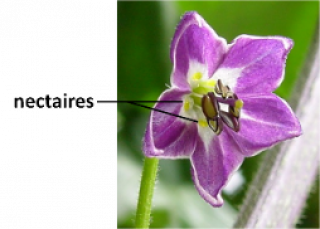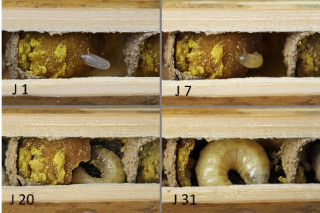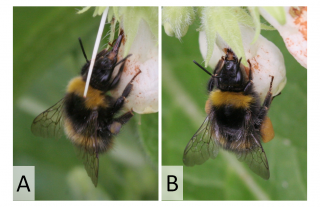Step 3: The insect is rewarded
A mutualistic relationship
Pollination ensures the sexual reproduction of plants. Pollination also provides insects with an advantage: the nectar or pollen on which they feed. Pollination is a mutualistic relationship, meaning that both partners benefit.
Nectar and pollen are sometimes referred to as rewards to emphasise that insects also benefit from pollination. Nectar has no other function than to attract insects to the flower. It is produced by glands called nectaries, which can be found at various points on the flower.
A goldmine of nutrients
Pollen contains a high proportion of protein (5 to 40%). It also contains carbohydrates (sugars), lipids (fats), minerals (calcium, copper, iron, magnesium, manganese, phosphorus, potassium, silicon, sulphur), vitamins (B1, B2, B3, B5, B6, B7, B8, B9, B12, C, D, E, H, PP and provitamin A) and enzymes (amylase, invertase and phosphatase).
The nectar is mainly composed of sugars including glucose, fructose and sucrose. It also contains smaller quantities of proteins, lipids and vitamins.
Behind all these complicated names, pollen and nectar are a real gold mine for insects, which find in them all the essential nutrients for the functioning of their bodies.
Pollen for growing up well
In this wild bee nest, each lodge protects a larva and contains a ball of fine yellow powder agglomerated in a sticky substance. The female has made these balls in the lodges before laying an egg. These are called pollen pellets and are a mixture of pollen and nectar that will be used to feed the larvae, the high protein content of the pollen makes it an excellent food for their growth.
The other stages of pollination :
Some of them cheat!
The mutualist relationship does not always work. Sometimes one of the two partners is harmed.
Some bumblebees have a tongue that is too short to reach the nectar of certain tube-shaped flowers. They make a small hole in the side of the tube to access the nectar from the side of the flower. They then feed on the nectar but do not pollinate the plant, as they do not come into contact with the pollen by passing through the side.
Orchids of the genus Ophrys do not produce nectar. Their labellum mimics the abdomen of female wild bees and emits an odour similar to the pheromones of these females. Male wild bees are attracted to these flowers that mimic their female and land on them in an attempt to mate. They leave with pollinia, pollen sacs on their heads or abdomens, and try to mate with other flowers. They pollinate the orchid but do not benefit from it as they do not find nectar. They do not feed on the pollen either. Ophrys flower early, coinciding with the hatching period of young, inexperienced males. Indeed, after a few disappointed couplings and especially with the arrival of the females, they will no longer visit these flowers with unfulfilled promises.




